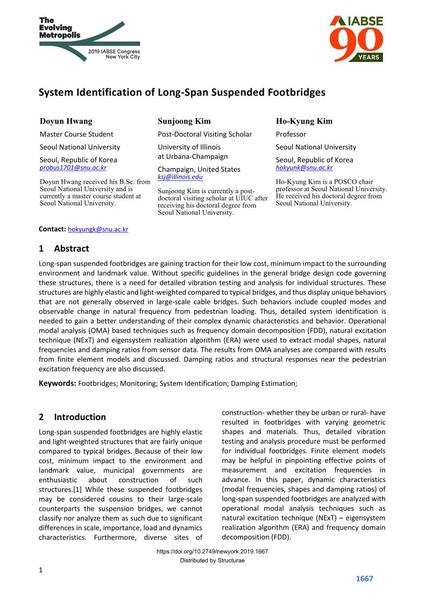System Identification of Long-Span Suspended Footbridges

|
|
|||||||||||
Bibliografische Angaben
| Autor(en): |
Doyun Hwang
(Seoul National University)
Sunjoong Kim (University of Illinois at Urbana-Champaign) Ho-Kyung Kim |
||||
|---|---|---|---|---|---|
| Medium: | Tagungsbeitrag | ||||
| Sprache(n): | Englisch | ||||
| Tagung: | IABSE Congress: The Evolving Metropolis, New York, NY, USA, 4-6 September 2019 | ||||
| Veröffentlicht in: | The Evolving Metropolis | ||||
|
|||||
| Seite(n): | 1667-1671 | ||||
| Anzahl der Seiten (im PDF): | 5 | ||||
| DOI: | 10.2749/newyork.2019.1667 | ||||
| Abstrakt: |
Long-span suspended footbridges are gaining traction for their low cost, minimum impact to the surrounding environment and landmark value. Without specific guidelines in the general bridge design code governing these structures, there is a need for detailed vibration testing and analysis for individual structures. These structures are highly elastic and light-weighted compared to typical bridges, and thus display unique behaviors that are not generally observed in large-scale cable bridges. Such behaviors include coupled modes and observable change in natural frequency from pedestrian loading. Thus, detailed system identification is needed to gain a better understanding of their complex dynamic characteristics and behavior. Operational modal analysis (OMA) based techniques such as frequency domain decomposition (FDD), natural excitation technique (NExT) and eigensystem realization algorithm (ERA) were used to extract modal shapes, natural frequencies and damping ratios from sensor data. The results from OMA analyses are compared with results from finite element models and discussed. Damping ratios and structural responses near the pedestrian excitation frequency are also discussed. |
||||
| Stichwörter: |
Fußgängerstege Fußgängerbrücken Monitoring
|
||||
